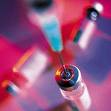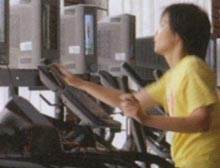การวิจัยครั้งนี้มีวัตถุประสงค์เพื่อ 1) เพื่อสร้างรูปแบบการพัฒนาคุณลักษณะอันพึงประสงค์ของนักเรียนโรงเรียนบัวใหญ่และ 2) เพื่อนำรูปแบบการพัฒนาคุณลักษณะอันพึงประสงค์ของนักเรียนโรงเรียนบัวใหญ่ไปใช้ ประชากรที่ใช้ในการศึกษาได้แก่ 1) นักเรียนโรงเรียนบัวใหญ่ ที่กำลังศึกษาอยู่ในปีการศึกษา 2558 - 2559 จำนวน 2,189 คน 2) บุคลากรที่เกี่ยวข้องกับการศึกษาคุณลักษณะ อันพึงประสงค์ของนักเรียนโรงเรียนบัวใหญ่ ประกอบด้วยบุคลากรต่าง ๆ ที่ปฏิบัติงานในปีการศึกษา 2558 - 2559 ในโรงเรียนบัวใหญ่ คือ ผู้บริหารสถานศึกษาโรงเรียน จำนวน 5 คน ครูผู้สอนโรงเรียนบัวใหญ่ จำนวน 116 คน คณะกรรมการสถานศึกษาขั้นพื้นฐานโรงเรียนบัวใหญ่ จำนวน 15 คน และผู้ปกครองนักเรียนโรงเรียนบัวใหญ่ที่มีบุตร หลานกำลังศึกษาอยู่ในปีการ 2558 - 2559 จำนวน 2,189 คน กลุ่มตัวอย่างได้แก่ (1) นักเรียนโรงเรียนบัวใหญ่ จำนวน 240 คน กำหนดกลุ่มตัวอย่างโดยใช้ตารางเครจซี่และมอร์แกน (Krejcie and Morgan, 1970) และใช้วิธีการสุ่มแบบแบ่งชั้น (Stratified Random Sampling) (2) บุคลากรที่ให้ข้อมูลเกี่ยวกับคุณลักษณะอันพึงประสงค์ของนักเรียนประกอบด้วย 2.1) ผู้บริหารสถานศึกษาโรงเรียน จำนวน 5 คน 2.2) ครูผู้สอนโรงเรียน บัวใหญ่ จำนวน 89 คน 2.3) คณะกรรมการสถานศึกษาขั้นพื้นฐาน จำนวน 14 คน 2.4) ผู้ปกครองนักเรียน จำนวน 240 คน เครื่องมือที่ใช้ในการศึกษา คือ (1) รูปแบบการพัฒนาคุณลักษณะอันพึงประสงค์ของนักเรียนโรงเรียนบัวใหญ่ (2) แบบประเมินความเหมาะสมของรูปแบบการพัฒนาคุณลักษณะอันพึงประสงค์ของนักเรียนโรงเรียนบัวใหญ่ (3) แบบสอบถามเกี่ยวกับพฤติกรรมของนักเรียน (4) แบบประเมินความพึงพอใจของนักเรียน สถิติที่ใช้ในการวิเคราะห์ข้อมูล ได้แก่ ร้อยละ ค่าเฉลี่ย (x̄) ค่าเบี่ยงเบนมาตรฐาน (S.D.) ค่าสัมประสิทธิความแปรผัน (C.V.) สถิติค่าที (t- test)
ผลการวิจัยพบว่า
1. รูปแบบการพัฒนาคุณลักษณะอันพึงประสงค์ของนักเรียนโรงเรียนบัวใหญ่ มี 6 องค์ประกอบ คือ (1) หลักการของรูปแบบ ประกอบด้วย 1.1) หลักการรูปแบบการพัฒนา 1.2) แนวทางการพัฒนาคุณลักษณะอันพึงประสงค์ 1.3) หลักการเรียนการสอนที่เน้นผู้เรียน เป็นศูนย์กลาง 1.4) หลักการบูรณาการการเรียนการสอน 1.5) หลักการจัดกิจกรรมนักเรียน (2) วัตถุประสงค์ของรูปแบบ (3) ระบบและกลไกของรูปแบบ ประกอบด้วย 3.1) ผู้อำนวยการสถานศึกษาโรงเรียนบัวใหญ่ 3.2) ฝ่ายบริหารวิชาการ 3.3) ฝ่ายบริหารกิจการนักเรียน 3.4) ฝ่ายบริหารทั่วไป 3.5) ฝ่ายบริหารส่งเสริมและบริการ (4) วิธีดำเนินงานของรูปแบบ ประกอบด้วย 4.1) พัฒนาศักยภาพในการเรียนรู้ 4.2) การบูรณาการภาคีเครือข่าย 4.3) การสร้างภูมิคุ้มกันด้วยสื่อเทคโนโลยี (5) การประเมินผลรูปแบบ) (6) เงื่อนไขของรูปแบบ ประกอบด้วย 6.1) ฝ่ายบริหารสถานศึกษาจะต้องตระหนักและให้ความสำคัญในการกำหนดนโยบายเพื่อพัฒนาคุณลักษณะอันพึงประสงค์ 4 ประการ ได้แก่ มีวินัย ใฝ่เรียนรู้ อยู่อย่างพอเพียง และมีจิตสาธารณะ 6.2) จัดให้มีโครงการเกี่ยวกับการพัฒนาคุณลักษณะอันพึงประสงค์ 6.3) ฝ่ายบริหารต้องมีระบบการประสานงานที่มีคุณภาพและมีความต่อเนื่องเป็นระบบ 6.4) มีการกำกับติดตามและประเมินผลอย่างต่อเนื่อง
2. ผลการนำรูปแบบการพัฒนาคุณลักษณะอันพึงประสงค์ของนักเรียนโรงเรียนบัวใหญ่ไปใช้
2.1 ผลการประเมินหลังการทดลองใช้รูปแบบการพัฒนาคุณลักษณะอันพึงประสงค์ของนักเรียนโรงเรียนบัวใหญ่ พบว่าความคิดเห็นของผู้บริหารสถานศึกษา ครู คณะกรรมการสถานศึกษา ขั้นพื้นฐานและผู้ปกครองนักเรียนมีความเห็นสอดคล้องกันว่า ในภาพรวมหลังการทดลองใช้รูปแบบนักเรียนมีคุณลักษณะอันพึงประสงค์ใน 4 ประการ ได้แก่ มีวินัย ใฝ่เรียนรู้ อยู่อย่างพอเพียง และมีจิตสาธารณะ อยู่ในระดับมากที่สุด (x̄ = 4.50) บุคคลทั้งสี่ประเภทมีความคิดเห็นในเรื่องดังกล่าวแตกต่างกันปานกลาง (C.V.= 13.16) และพบว่าเมื่อเปรียบเทียบก่อนการทดลองใช้รูปแบบนักเรียนมีพฤติกรรมอยู่ในระดับปานกลาง แต่หลังการทดลองนักเรียนมีพฤติกรรมดีขึ้นอย่างมีนัยสำคัญทางสถิติที่ระดับ =0.01
2.2 ผลการประเมินผลความพึงพอใจของนักเรียนที่มีต่อรูปแบบการพัฒนาคุณลักษณะ อันพึงประสงค์ของนักเรียนโรงเรียนบัวใหญ่ พบว่านักเรียนมีความพึงพอใจต่อการใช้รูปแบบการพัฒนาคุณลักษณะอันพึงประสงค์ของนักเรียนโรงเรียนบัวใหญ่ใน 4 ประการ ได้แก่ มีวินัย ใฝ่เรียนรู้ อยู่อย่างพอเพียง และมีจิตสาธารณะในภาพรวมอยู่ในระดับมากที่สุด (x̄ = 4.52) ความคิดเห็นของนักเรียนในเรื่องดังกล่าวแตกต่างกันปานกลาง (C.V.= 13.71) ด้านที่มีระดับมากที่สุด ได้แก่ ด้านการสร้างภูมิคุ้มกันด้วยสื่อเทคโนโลยี (x̄ = 4.55) ด้านผู้บริหาร และครู (x̄ = 4.54) และด้านการจัดบรรยากาศภายในสถานศึกษา (x̄ = 4.53) ตามลำดับ
2.3 ผลการติดตามประเมินผลการทดลองใช้รูปแบบการพัฒนาคุณลักษณะอันพึงประสงค์ของนักเรียนโรงเรียนบัวใหญ่ พบว่าความคิดเห็นของผู้บริหารสถานศึกษา ครู คณะกรรมการสถานศึกษาขั้นพื้นฐานและผู้ปกครองนักเรียนมีความเห็นสอดคล้องกันว่า ในภาพรวมการติดตามการทดลองใช้รูปแบบนักเรียนมีคุณลักษณะอันพึงประสงค์ใน 4 ประการ ได้แก่ มีวินัย ใฝ่เรียนรู้ อยู่อย่างพอเพียง และมีจิตสาธารณะ อยู่ในระดับมากที่สุด (x̄ = 4.64) บุคคลทั้งสี่ประเภทมีความคิดเห็นในเรื่องดังกล่าวแตกต่างกัน ปานกลาง (C.V.= 11.42) และพบว่าหลังการทดลองนักเรียนยังคงมีพฤติกรรมอยู่ในระดับมากที่สุดและสูงขึ้นอย่างมีนัยสำคัญทางสถิติที่ระดับ =0.01 ยังคงมีคุณลักษณะอันพึงประสงค์ทั้งสามด้านนั้นอยู่ในระดับดี
คำสำคัญ : รูปแบบการพัฒนาคุณลักษณะอันพึงประสงค์
Abstarct
This research aimed to 1) formulate a model for developing desired characteristics of the students of Buayai school, and 2) try out the model. The research population included 1) 2189 students studying at Buayai School during the academic years of 2015-2016, 2) the school personnel of Buayai School who got involved with the development of desired characteristics and worked at the school during the academic years of 2015-2016 including 5 administrators, 116 teachers, 15 school councilors, and 2189 parents/ guardians of the students studying in school during the academic years of 2015-2016. Based on Krejcie and Morgan table of sample size (Krejcie and Morgan, 1970) and Stratified Random Sampling method, the sample group comprised (1) 240 students, (2) the school personnel who were the research informants on desired characteristics; namely, 2.1) 5 administrators , 2.2) 89 teachers, 2.3) 14 school councilors, 2.4) 240 parents/ guardians of the students. The research instruments used in this study were (1) a model for developing desired characteristics of the students of Buayai school, (2) a form to assess an appropriateness of the model for developing desired characteristics of the students of Buayai school, (3) a questionnaire on students behaviors, and (4) an assessment form on students satisfaction. The statistics used to analyze data included the percentage, mean, standard deviation (S.D), coefficient of variation (C.V.), and t-test.
The research findings revealed as follows:
1. The model for developing desired characteristics of the students of Buayai school consisted of 6 components: (1) principles on models including 1.1) development model principles, 1.2) guidelines for developing desired characteristics, 1.3) principles on student-centered instruction, 1.4) principles on integrated teaching and learning, 1.5) principles on organizing students activities; (2) objectives of the model; (3) model system and mechanisms which included 3.1) director of Buayai School, 3.2) academic administration , 3.3) students affairs administration, 3.4) general affairs administration, 3.5) promotion and service administration; (4) the model implementation consisting of 4.1) developing learning potentials, 4.2 ) integrating school networks, 4.3) building immunity through technology, and (5) model evaluation.
2. The results from trying out the model for developing desired characteristics of the students of Buayai School.
2.1 As a whole, after trying out the model, the result indicated that the school administrators, teachers, school councilors, and parents/ guardians of the students were in congruence in their opinions on desired characteristics for students in 4 aspects; namely, self-discipline, learning enthusiasm, self-sufficiency and public mind, the highest level (4.50). The samples of four categories showed different opinions on the same aspects at a moderate level (C.V.=13.16). In comparison between pre and post experiments, it was found that students behavioral performances were at a moderate level in the pre- experiment stage, but in the post- experiment stage, their behaviors were improved with statistical significance at 0.01 level.
2.2 The result showing the studentss satisfaction on the model for developing desired characteristics of the students of Buayai School indicated that the students were satisfied with four aspects of the model including self-discipline, learning enthusiasm, self-sufficiency and public mind, as a whole, at the highest level (4.52). They showed different opinions on the same aspects at a moderate level (C.V.=13.71) ranging from building immunity through technology (4.55), administrators and teachers (4.54) and school atmosphere (4.53) respectively.
2.3 In the following up stage after the experiment of the model for developing desired characteristics of the students of Buayai School, it was found that the school administrators, teachers, school councilors, and parents/ guardians of the students were in line in their opinions in using the model to follow up four desired characteristics of students: self-discipline, learning enthusiasm, self-sufficiency and public mind at the highest level (4.64). The samples of four categories showed different opinions at a moderate level (C.V.=11.42). Moreover, the research revealed that after experiment, students maintained their behavioral performances at the highest level at the statistical significance at 0.01 level. The other three aspects of desired characteristics were rated at a high level.
Key words : model for developing desired characteristics



 ค้นหาทุกอย่างในเว็บครูบ้านนอก :
ค้นหาทุกอย่างในเว็บครูบ้านนอก :































